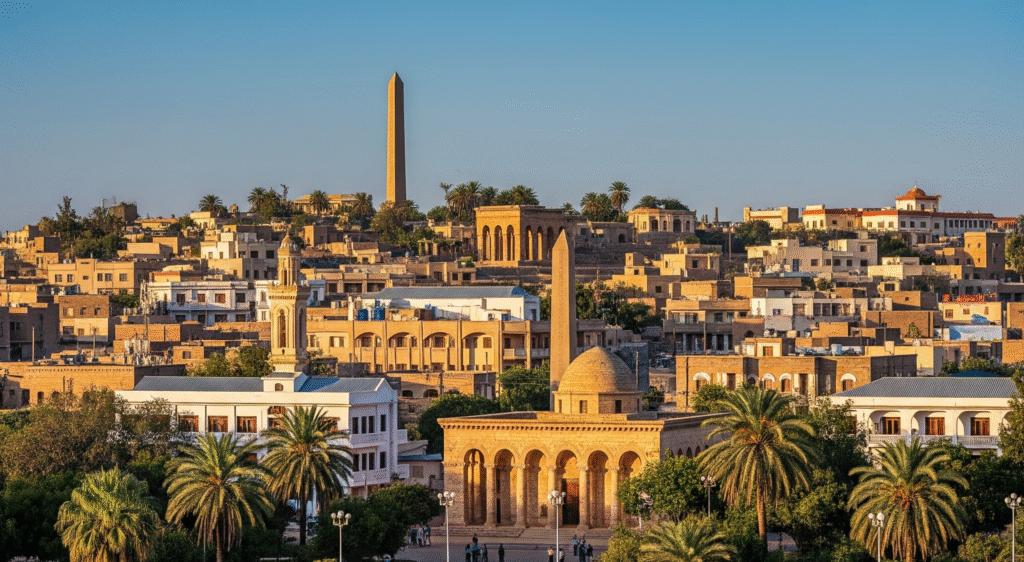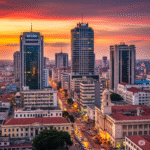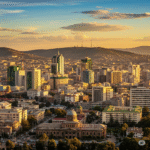
Planning Your Trip to Axum, Ethiopia: Ancient History & Culture
Georgia
This section is mislabeled. It should refer to Ethiopia.
Time Zone: GMT+3
Note: Georgia’s Time Zone is GMT+4 not GMT+3.
Language: Amharic (Official), Tigrinya
While Georgian is spoken in the country of Georgia. Amharic is the official language of Ethiopia. Tigrinya is also widely spoken in the Tigray region where Axum is located.
Currency: Ethiopian Birr (ETB)
Georgian Lari (GEL) is not the currency. The correct currency to use in Ethiopia is Ethiopian Birr (ETB)
Weather & Climate in Axum: Best Time to Visit Ethiopia
Axum experiences a temperate climate. Spring (April-May) sees pleasant temperatures, averaging between 15-25°C (59-77°F). Summer (June-August) is warm and humid, with temperatures ranging from 22-32°C (72-90°F). Autumn (September-October) offers comfortable weather, around 15-25°C (59-77°F). Winter (November-March) is mild, with temperatures between 5-15°C (41-59°F). Rainfall is spread throughout the year, with slightly drier conditions in the winter months. For the best weather, consider visiting during the autumn months.
Axum City Overview: History & Culture of Ancient Ethiopia
Axum, a UNESCO World Heritage Site, is a city steeped in ancient history and Ethiopian Orthodox Christian tradition. As the former capital of the Aksumite Empire (1st to 7th centuries AD), Axum boasts a remarkable collection of obelisks, tombs, and ancient ruins. Explore the iconic Obelisks of Axum, delve into the Church of St. Mary of Zion (rumored home of the Ark of the Covenant), and discover the tombs of ancient kings. Beyond the historical landmarks, experience the vibrant local culture, from bustling markets to traditional Ethiopian coffee ceremonies. Axum offers a glimpse into a rich and fascinating past, captivating history enthusiasts and cultural explorers. Don’t miss the chance to see Ezana’s Stone, an ancient inscription detailing the conversion to Christianity.
Best Time to Visit Axum, Ethiopia: Seasonal Travel Guide
Seasonal Pros and Cons for Planning Your Trip:
- Spring (April-May): Pros: Pleasant temperatures, blooming landscapes, fewer crowds than peak season. Cons: Occasional rainfall is possible.
- Summer (June-August): Pros: Lush greenery, fewer tourists. Cons: Hot and humid weather, potential for heavier rainfall.
- Autumn (September-October): Pros: Comfortable temperatures, clear skies, ideal for sightseeing. Cons: Shoulder season, may see slightly increased prices.
- Winter (November-March): Pros: Mild temperatures, fewer tourists, ideal for exploring historical sites. Cons: Occasional showers, cooler evenings.
How to Get to Axum & Visa Requirements for Ethiopia Travel
Flights, visas, and airport transfers:
- The nearest international airport is Axum Airport (AXU), but flights may be limited. Bole International Airport (ADD) in Addis Ababa is the primary international hub, requiring a connecting flight to Axum.
- Flights can be booked via Ethiopian Airlines and other major carriers connecting through Addis Ababa. Search for flights to Axum via Skyscanner or Google Flights.
- Visa requirements should be checked with the Ethiopian embassy or consulate in your country of residence *before* your trip. Apply for an e-Visa online for faster processing.
- Airport transfers in Axum can be arranged through hotels or local taxi services. Negotiate the price beforehand.
Fun Fact: The Ark of the Covenant in Axum
Legend says the Ark of the Covenant is housed in the Church of St. Mary of Zion in Axum. Access is strictly limited; only the guardian monk is allowed to view it.
Famous People from Axum: Ancient Ethiopian Royalty
Queen of Sheba, King Ezana, King Kaleb, and various Ethiopian emperors of the Aksumite Empire are associated with this historical city.
Top 10 Attractions in Axum, Ethiopia: Must-See Sites
- Obelisks of Axum (Northern Stelae Park)
- Address: Northern Stelae Park, Axum
- Description: Massive granite obelisks, symbols of the Aksumite Empire’s power and engineering prowess. Photo opportunities are excellent here, especially at sunrise or sunset.
- Church of St. Mary of Zion
- Address: Axum, Tigray
- Description: A complex of churches, including the old and new St. Mary of Zion churches. Important in Ethiopian Orthodox tradition, and reputedly home to the Ark of the Covenant. Note that women are not permitted to enter the original church building.
- Tombs of Kings Kaleb and Gebre Meskel
- Address: Near St. Mary of Zion Church, Axum
- Description: Ancient tombs believed to be the resting places of Aksumite kings. They showcase the empire’s wealth and artistry.
- Dungur Palace (Queen of Sheba’s Palace Ruins)
- Address: Outside of Axum city center
- Description: Archaeological site believed to be the ruins of the Queen of Sheba’s palace. It offers insights into ancient Aksumite architecture.
- Ezana’s Stone
- Address: Axum city center
- Description: A stone tablet with inscriptions in Ge’ez, Sabaean, and Greek. It details King Ezana’s conversion to Christianity.
- Mai Shum (Queen of Sheba’s Bath)
- Address: Outside of Axum city center
- Description: A historic water reservoir, said to have been used by the Queen of Sheba. It showcases ancient Aksumite water management systems.
- Lioness of Gobedra
- Address: Outside of Axum city center
- Description: Pre-Aksumite rock art depicting a lioness. Provides evidence of early human occupation in the region.
- Axum Museum
- Address: Axum city center
- Description: Museum housing artifacts and exhibits related to the Aksumite Empire. It provides a comprehensive overview of its history and culture.
- Ta’akha Maryam
- Address: Near Axum city center
- Description: Ruins of an ancient structure. Offers insights into the Aksumite architectural style.
- Abba Pantaleon Monastery
- Address: On a hilltop near Axum
- Description: Monastery perched on a steep cliff, offering panoramic views and a glimpse into Ethiopian monastic life. Note that women cannot enter this monastery.
Axum’s Hidden Gems: Off the Beaten Path in Ethiopia
- Enda Abune Aregawi Monastery (Debre Damo)
- Address: Debre Damo, near Axum (access requires a challenging climb)
- Description: This monastery is accessible only by rope. It is a challenging but rewarding climb, offering stunning views and a glimpse into monastic life. Note: only men can access this site.
- The Lesser-Known Stelae Fields
- Address: Around Axum
- Description: Explore the smaller, less visited stelae for a more intimate experience with the ancient monuments, away from the main tourist crowds.
Local Festivals & Events in Axum, Ethiopia
- Timket (Ethiopian Epiphany) – January 19th (A major religious celebration, a great time to visit)
- Fasika (Ethiopian Easter) – Date varies (Celebrated with unique traditions)
- Kidus Yohannes (Feast of St. John) – September 11th (The Ethiopian New Year)
Day Trips from Axum: Exploring Northern Ethiopia
- Yeha Temple (1-2 hours drive) – Pre-Aksumite temple ruins.
- Debre Damo Monastery (2-3 hours drive) – Monastery accessible only by rope (men only).
Photography Spots in Axum: Instagram-Worthy Views
- The Obelisks of Axum at sunrise or sunset (golden hour is magic).
- The Church of St. Mary of Zion during a religious ceremony (be respectful).
- Panoramic views from the Abba Pantaleon Monastery (stunning vistas).
Where to Stay in Axum & Getting Around
Recommended Length of Stay in Axum
3-4 days allows sufficient time to explore the main attractions and take a day trip.
Top Places to Stay in Axum: Hotels for Every Budget
Budget Hotels in Axum
- Remhai Hotel: Address: Axum
- Consolar Hotel: Address: Axum
- Yohannes Hotel: Address: Axum
Mid-Range Hotels in Axum
- Yeha Hotel: Address: Axum
- Delina Hotel: Address: Axum
- Sabean International Hotel: Address: Axum
Luxury Hotels in Axum
- Nox Hotel: Address: Axum
Getting Around Axum City: Transportation Options
Public transport is limited. Taxis and *bajajs* (three-wheeled vehicles) are readily available. Walking is suitable for exploring the central area. Negotiate taxi fares before starting your journey.
Preparing for Your Axum Experience: Travel Tips
What to Pack for Ethiopia
Comfortable walking shoes are a must. Pack modest clothing for visiting religious sites. Bring sunscreen, insect repellent, a hat, and a light jacket. A universal adapter may be needed for electronics.
Useful Apps for Travel in Ethiopia
- Google Translate (for Amharic).
- Maps.me (offline maps, download Ethiopia map before your trip).
- Currency Converter (to easily calculate ETB exchange rates).
Safety Tips & Cultural Etiquette in Axum
Be respectful of religious customs. Dress modestly when visiting churches and monasteries. Ask for permission *before* taking photos of people. Avoid discussing sensitive political topics. Be aware of your surroundings and take precautions against petty theft. Learn a few basic Amharic phrases. Tipping is customary in restaurants and for services.
Food, Fun & Finds: Axum’s Culinary Delights & Shopping
Top Restaurants in Axum
- Africa Hotel Restaurant
- Address: Axum
- Description: Offers a variety of local Ethiopian dishes and international cuisine. A good option for trying *injera* and *wat*.
Must-Try Ethiopian Dishes in Axum
- Injera with various stews (*wat*).
- Tibs (fried meat).
- Shiro (chickpea stew).
- Tej (honey wine).
- Ethiopian coffee ceremony.
Nightlife & Entertainment in Axum
Local bars and cafes in Axum offer a relaxed atmosphere for socializing and enjoying traditional music. Don’t expect a vibrant nightlife scene.
What to Buy in Axum: Souvenirs & Local Products
- Handwoven textiles (scarves, shawls, and traditional clothing).
- Ethiopian coffee (whole beans or ground).
- Religious icons and crosses (available in various styles and materials).
- Local crafts and souvenirs from the markets (baskets, pottery, and wood carvings).




